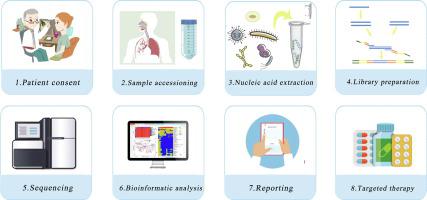Journal of Advanced Research ( IF 11.4 ) Pub Date : 2021-09-29 , DOI: 10.1016/j.jare.2021.09.012 Zhenli Diao 1, 2, 3 , Dongsheng Han 4 , Rui Zhang 1, 3 , Jinming Li 1, 2, 3

|
Background
Metagenomic next-generation sequencing (mNGS) has changed the diagnosis landscape of lower respiratory tract infections (LRIs). With the development of newer sequencing assays, it is now possible to assess all microorganisms in a sample using a single mNGS analysis. The applications of mNGS for LRIs span a wide range of areas including LRI diagnosis, airway microbiome analyses, human host response analyses, and prediction of drug resistance. mNGS is currently in an exciting transitional period; however, before implementation in a clinical setting, there are several barriers to overcome, such as the depletion of human nucleic acid, discrimination between colonization and infection, high costs, and so on.
Aim of Review: In this review, we summarize the potential applications and challenges of mNGS in the diagnosis of LRIs to promote the integration of mNGS into the management of patients with respiratory tract infections in a clinical setting.
Key Scientific Concepts of Review: Once its analytical validation, clinical validation and clinical utility been demonstrated, mNGS will become an important tool in the field of infectious disease diagnosis.
中文翻译:

宏基因组学下一代测序测试在下呼吸道感染的诊断中占据一席之地
背景
宏基因组下一代测序 (mNGS) 改变了下呼吸道感染 (LRI) 的诊断格局。随着更新的测序分析的发展,现在可以使用单个 mNGS 分析来评估样品中的所有微生物。mNGS 在 LRI 中的应用涵盖了广泛的领域,包括 LRI 诊断、气道微生物组分析、人类宿主反应分析和耐药性预测。mNGS 目前正处于一个激动人心的过渡期;然而,在临床实施之前,有几个障碍需要克服,例如人类核酸的消耗、定植和感染的区分、高成本等。
综述目的:在这篇综述中,我们总结了 mNGS 在 LRI 诊断中的潜在应用和挑战,以促进将 mNGS 整合到临床环境中呼吸道感染患者的管理中。
审查的关键科学概念:一旦其分析验证、临床验证和临床实用性得到证实,mNGS 将成为传染病诊断领域的重要工具。











































 京公网安备 11010802027423号
京公网安备 11010802027423号